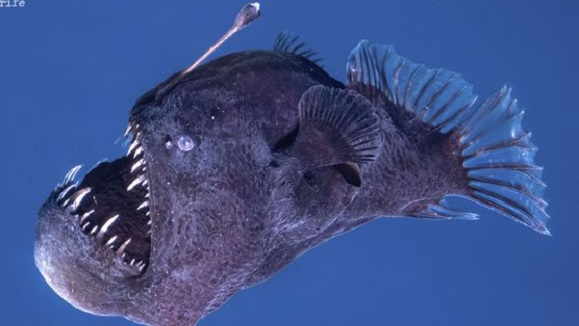
Canaria, 8 Feb. - In Finding Nemo (2003), little Dory and Marlin faced a terrifying creature in the abyssal depths: a fish with a luminescent biological trap and a mouth full of sharp teeth. That scene, which made the black devil, or abyssal anglerfish (Melanocetus johnsonii), popular, seemed taken from an underwater nightmare.
However, what just a few days ago seemed exclusive to fiction has come to life in the waters of the Canary archipelago: probably for the first time in history, an adult specimen of this species has been sighted and recorded alive on the surface, in broad daylight.
The extraordinary encounter took place just 2 km from the coast of Tenerife, during an expedition of the NGO Condrik-Tenerife, dedicated to the study of pelagic sharks. It was marine biologist Laia Valor who detected the unusual silhouette of the fish floating on the surface. Immediately, the team made up of biologists Marc Martín and Antonio Sabuco, together with marine fauna photographer David Jara, documented the discovery with unpublished images.
To date, all records of Melanocetus johnsonii corresponded to larvae, dead specimens or recordings obtained by underwater vehicles in areas up to 2,000 meters deep. So what was a predator of the shadows doing emerging into the sunlight?
A hunter of shadows, lost on the surface
The black devil is an abyssal fish that lives on the seabed between 200 and 2,000 meters deep, where sunlight does not reach and bioluminescence becomes a key tool for survival. Its iconic luminous antenna, packed with symbiotic bacteria, acts as a lure that attracts its prey before being devoured in a single bite.
But this time, the creature was completely out of its natural habitat. Its appearance in surface waters remains a mystery, so hypotheses include an ascending current, a pathology that affects its swimming ability, or escape from a predator.
Despite its disturbing appearance, the black devil is harmless to humans. And beyond its bioluminescence and its role in the food chain, this species belongs to an order of fish that presents one of the most extreme mating strategies in the animal kingdom.
In some species of the same family, the males—much smaller than the females—literally fuse with their partner forever. Unable to survive on their own in the immensity of the ocean, they attach themselves to the female, atrophying their organs until they become a simple sperm reservoir. The female can then reproduce whenever she wants, with her partner integrated into her own body.
A sighting for history
This discovery, which has been registered in the Network of Observers of the Marine Environment in the Canary Islands (RedPROMAR, for its acronym in Spanish), represents a milestone in marine biology. The documentation of the sighting is proof of the value of citizen science and marine research in the archipelago.
The Condrik-Tenerife team, with authorization from the Ministry for Ecological Transition and the Demographic Challenge, continues its work in exploring the mysteries of the ocean. And although this encounter with the black devil has been an unexpected stroke of luck, its impact on the scientific community could illuminate new paths in the study of the depths.
After all, we still have much to discover about the creatures that lurk in the dark. (Text and Photo: Cubadebate)